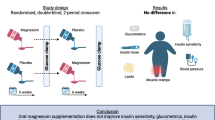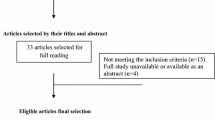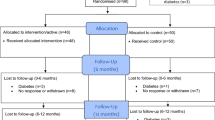Abstract
Glucagon dysregulation is an essential component in the pathophysiology of type 2 diabetes. Studies in vitro and in animal models have shown that zinc co-secreted with insulin suppresses glucagon secretion. Zinc supplementation improves blood glucose control in patients with type 2 diabetes, although there is little information about how zinc supplementation may affect glucagon secretion. The objective of this study was to evaluate the effect of 1-year zinc supplementation on fasting plasma glucagon concentration and in response to intravenous glucose and insulin infusion in patients with type 2 diabetes. A cross-sectional study was performed after 1-year of intervention with 30 mg/day zinc supplementation or a placebo on 28 patients with type 2 diabetes. Demographic, anthropometric, and biochemical parameters were determined. Fasting plasma glucagon and in response to intravenous glucose and insulin infusion were evaluated. Patients of both placebo and supplemented groups presented a well control of diabetes, with mean values of fasting blood glucose and glycated hemoglobin within the therapeutic goals established by ADA. No significant differences were observed in plasma glucagon concentration, glucagon/glucose ratio or glucagon/insulin ratio fasting, after glucose or after insulin infusions between placebo and supplemented groups. No significant effects of glucose or insulin infusions were observed on plasma glucagon concentration. One-year zinc supplementation did not affect fasting plasma glucagon nor response to intravenous glucose or insulin infusion in well-controlled type 2 diabetes patients with an adequate zinc status.

Similar content being viewed by others
References
Jiang G, Zhang BB (2003) Glucagon and regulation of glucose metabolism. Am J Physiol Endocrinol Metab 284(4):E671–E678. https://doi.org/10.1152/ajpendo.00492.2002
Gromada J, Franklin I, Wollheim CB (2007) Alpha-cells of the endocrine pancreas: 35 years of research but the enigma remains. Endocr Rev 28(1):84–116. https://doi.org/10.1210/er.2006-0007
Quesada I, Tuduri E, Ripoll C, Nadal A (2008) Physiology of the pancreatic alpha-cell and glucagon secretion: role in glucose homeostasis and diabetes. J Endocrinol 199(1):5–19. https://doi.org/10.1677/JOE-08-0290
Unger RH, Orci L (1975) The essential role of glucagon in the pathogenesis of diabetes mellitus. Lancet 1(7897):14–16
Dunning BE, Gerich JE (2007) The role of alpha-cell dysregulation in fasting and postprandial hyperglycemia in type 2 diabetes and therapeutic implications. Endocr Rev 28(3):253–283. https://doi.org/10.1210/er.2006-0026
Maret W (2013) Zinc biochemistry: from a single zinc enzyme to a key element of life. Adv Nutr 4(1):82–91. https://doi.org/10.3945/an.112.003038
Foster MC, Leapman RD, Li MX, Atwater I (1993) Elemental composition of secretory granules in pancreatic islets of Langerhans. Biophys J 64(2):525–532. https://doi.org/10.1016/S0006-3495(93)81397-3
Dunn MF (2005) Zinc-ligand interactions modulate assembly and stability of the insulin hexamer—a review. Biometals 18(4):295–303. https://doi.org/10.1007/s10534-005-3685-y
Qian WJ, Gee KR, Kennedy RT (2003) Imaging of Zn2+ release from pancreatic beta-cells at the level of single exocytotic events. Anal Chem 75(14):3468–3475. https://doi.org/10.1021/ac0341057
Ishihara H, Maechler P, Gjinovci A, Herrera PL, Wollheim CB (2003) Islet beta-cell secretion determines glucagon release from neighbouring alpha-cells. Nat Cell Biol 5(4):330–335. https://doi.org/10.1038/ncb951
Franklin I, Gromada J, Gjinovci A, Theander S, Wollheim CB (2005) Beta-cell secretory products activate alpha-cell ATP-dependent potassium channels to inhibit glucagon release. Diabetes 54(6):1808–1815. https://doi.org/10.2337/diabetes.54.6.1808
Zhou H, Zhang T, Harmon JS, Bryan J, Robertson RP (2007) Zinc, not insulin, regulates the rat alpha-cell response to hypoglycemia in vivo. Diabetes 56(4):1107–1112. https://doi.org/10.2337/db06-1454
Gyulkhandanyan AV, Lu H, Lee SC, Bhattacharjee A, Wijesekara N, Fox JE, MacDonald PE, Chimienti F, Dai FF, Wheeler MB (2008) Investigation of transport mechanisms and regulation of intracellular Zn2+ in pancreatic alpha-cells. J Biol Chem 283(15):10184–10197. https://doi.org/10.1074/jbc.M707005200
Slucca M, Harmon JS, Oseid EA, Bryan J, Robertson RP (2010) ATP-sensitive K+ channel mediates the zinc switch-off signal for glucagon response during glucose deprivation. Diabetes 59(1):128–134. https://doi.org/10.2337/db09-1098
Chausmer AB (1998) Zinc, insulin and diabetes. J Am Coll Nutr 17(2):109–115. https://doi.org/10.1080/07315724.1998.10718735
Jayawardena R, Ranasinghe P, Galappatthy P, Malkanthi R, Constantine G, Katulanda P (2012) Effects of zinc supplementation on diabetes mellitus: a systematic review and meta-analysis. Diabetol Metab Syndr 4(1):13. https://doi.org/10.1186/1758-5996-4-13
Capdor J, Foster M, Petocz P, Samman S (2013) Zinc and glycemic control: a meta-analysis of randomised placebo controlled supplementation trials in humans. J Trace Elem Med Biol 27(2):137–142. https://doi.org/10.1016/j.jtemb.2012.08.001
Sladek R, Rocheleau G, Rung J, Dina C, Shen L, Serre D, Boutin P, Vincent D, Belisle A, Hadjadj S, Balkau B, Heude B, Charpentier G, Hudson TJ, Montpetit A, Pshezhetsky AV, Prentki M, Posner BI, Balding DJ, Meyre D, Polychronakos C, Froguel P (2007) A genome-wide association study identifies novel risk loci for type 2 diabetes. Nature 445(7130):881–885. https://doi.org/10.1038/nature05616
Hegazi SM, Ahmed SS, Mekkawy AA, Mortagy MS, Abdel-Kadder M (1992) Effect of zinc supplementation on serum glucose, insulin, glucagon, glucose-6-phosphatase, and mineral levels in diabetics. J Clin Biochem Nutr 12(3):209–215. https://doi.org/10.3164/jcbn.12.209
Levey AS, Coresh J, Greene T, Stevens LA, Zhang YL, Hendriksen S, Kusek JW, Van Lente F (2006) Using standardized serum creatinine values in the modification of diet in renal disease study equation for estimating glomerular filtration rate. Ann Intern Med 145(4):247–254. https://doi.org/10.7326/0003-4819-145-4-200608150-00004
Dolgin M, New York Heart Association Criteria Committee (1994) Nomenclature and criteria for diagnosis of diseases of the heart and great vessels, 9th edn. Little Brown, Boston
Smith JC Jr, Butrimovitz GP, Purdy WC (1979) Direct measurement of zinc in plasma by atomic absorption spectroscopy. Clin Chem 25(8):1487–1491
Higgins JJ, Clifford BR, Tashtoush S (1990) The aligned rank transform procedure. Annual Conference on Applied Statistics in Agriculture—2nd Annual Conference Proceedings: p 185–195
Lee Y, Wang MY, Du XQ, Charron MJ, Unger RH (2011) Glucagon receptor knockout prevents insulin-deficient type 1 diabetes in mice. Diabetes 60(2):391–397. https://doi.org/10.2337/db10-0426
Lee Y, Berglund ED, Yu X, Wang MY, Evans MR, Scherer PE, Holland WL, Charron MJ, Roth MG, Unger RH (2014) Hyperglycemia in rodent models of type 2 diabetes requires insulin-resistant alpha cells. Proc Natl Acad Sci U S A 111(36):13217–13222. https://doi.org/10.1073/pnas.1409638111
Cho YM, Merchant CE, Kieffer TJ (2012) Targeting the glucagon receptor family for diabetes and obesity therapy. Pharmacol Ther 135(3):247–278. https://doi.org/10.1016/j.pharmthera.2012.05.009
Christensen M, Bagger JI, Vilsboll T, Knop FK (2011) The alpha-cell as target for type 2 diabetes therapy. Rev Diabet Stud 8(3):369–381. https://doi.org/10.1900/RDS.2011.8.369
Pearson MJ, Unger RH, Holland WL (2016) Clinical trials, triumphs, and tribulations of glucagon receptor antagonists. Diabetes Care 39(7):1075–1077. https://doi.org/10.2337/dci15-0033
Brown KH, Rivera JA, Bhutta Z, Gibson RS, King JC, Lonnerdal B, Ruel MT, Sandtrom B, Wasantwisut E, Hotz C (2004) International Zinc Nutrition Consultative Group (IZiNCG) technical document #1. Assessment of the risk of zinc deficiency in populations and options for its control. Food Nutr Bull 25(1 Suppl 2):S91–204
Ruz M, Carrasco F, Sanchez A, Perez A, Rojas P (2016) Does zinc really “metal” with diabetes? The epidemiologic evidence. Curr Diab Rep 16(11):111. https://doi.org/10.1007/s11892-016-0803-x
American Diabetes Association (2017) Glycemic targets. Sec. 6. In: standards in medical care in diabetes—2017. Diabetes Care 40(Suppl 1):S48–S56. https://doi.org/10.2337/dc17-S009
Unger RH, Orci L (2010) Paracrinology of islets and the paracrinopathy of diabetes. Proc Natl Acad Sci U S A 107(37):16009–16012. https://doi.org/10.1073/pnas.1006639107
Funding
This research was funded by the National Fund for Development of Science and Technology (FONDECYT), research project 1120323. A.P. was recipient of National Commission for Research in Science and Technology (CONICYT) National Doctoral Fellowship.
Author information
Authors and Affiliations
Contributions
A.P., J.C., and J.I. collected and analyzed samples. A.P. performed statistical analyses. A.P. and M.R. interpreted the results and wrote the manuscript. A.P., P.R., F.C., K.B., F.P., and M.R. reviewed and edited the final manuscript.
Corresponding author
Ethics declarations
Ethical Approval
All procedures performed in studies involving human participants were in accordance with the ethical standards of the institutional research committee and with the 1964 Helsinki declaration and its later amendments or comparable ethical standards. The study protocol was approved by ethics committee of the Faculty of Medicine, University of Chile. All patients gave their informed consent prior to the beginning of the study.
Conflict of Interest
M.R., P.R., F.C., K.B., F.P., and J.I. were coauthors of the research project Fondecyt 1120323. The rest of authors declare that they have no conflict of interest.
Electronic supplementary material
Online resource 1
(PDF 307 kb)
Rights and permissions
About this article
Cite this article
Pérez, A., Rojas, P., Carrasco, F. et al. Zinc Supplementation Does Not Affect Glucagon Response to Intravenous Glucose and Insulin Infusion in Patients with Well-Controlled Type 2 Diabetes. Biol Trace Elem Res 185, 255–261 (2018). https://doi.org/10.1007/s12011-018-1249-6
Received:
Accepted:
Published:
Issue Date:
DOI: https://doi.org/10.1007/s12011-018-1249-6




